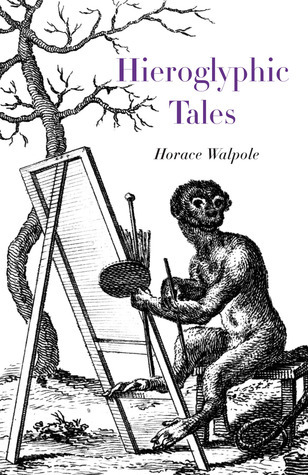Horry Walpole was a peculiar man, wasn’t he? Before I read The Castle of Otranto, or Selected Letters, I read Hieroglyphic Tales, which I bought after a trip to his fake castle, Strawberry Hill. I thought it worth a re-read.
It starts with a preface where he (of course) pretends to be a Grub Street hack who lives up the top of a rented building, because the air up there helps his asthma, naturally. He says he’s printing thousands of copies of these tales so that they will survive the inevitable death of print culture which will go the same way as creating new religions, teaching elephants to walk a slack rope and writing readable epics. In truth, Walpole printed seven copies, though he wrote some of the tales as letters to friends.
The fake Grub Street author claims that the stories in the book pre-date the creation of the world, or were created last week, or whatever. He says the original author may have been Kemanrlegurpikos, son of Quat, but it may not have been. (That joke reminded me of the Nu-Who planet of Raxicoricophallapatorius and it’s sister planet, Clom). We are told these tales contain all the great secrets of history, originally written in hieroglyphics. A claim no dafter than Athanasius Kircher’s attempts.
While many of Walpole’s activities have a dilettantish quality, these tales are truly just him cutting lose, created extempore, the best ones are daft, camp riffs on fairy-tales, politics and silliness. The lesser ones are a little grating.
The first is about a princess out collecting goat eggs who finds a kingdom on the other side of the mountain. She’s captured and taken to the emperor, who has a new wife every night who tells him tales before being killed in the morning. Our intrepid Scheherazade bores the emperor to death with a history of church politics and becomes empress herself. This is a fun one, from the geographical absurdities at the beginning to the sheer irritation the emperor has with the ridiculousness of church schisms.
The second is about a king with three daughters who wants to marry them off sequentially. The problem is that the first daughter doesn’t exist but this is solved when a prince-suitor arrives because he’s dead. Complications ensue. One particularly silly detail is that the dead man has three legs, so the third daughter (who only has one) pines out of love because she feels he could complete her. The prince is also from a country with a brilliantly vulgar name, Quifferiquimini. One of my favourites.
The third tale is my favourite and starts with another brilliantly silly name. She is the princess Pissimissi, the Lady of the Jordan (a Jordan being nickname for a toilet). Her father dies leaving her a carriage made out of a pistachio shell pulled by an elephant and a ladybird, she whips them both and they perform equal pulling duty. In the course of her travels, they accidentally suffocate a tower full of husbands owned by a witch. She sets demons after them which a dispelled by the elephant’s fart. They collect all sorts of objects before being taken up by a hummingbird to the court of King Solomon the Wise who declares Pissimissi to be his favourite wife, thus upsetting the Queen of Sheba.
What makes the third tale my favourite, aside from the string of ludicrous incidents, is the level of detail. The witch has 17,000 husbands and releases 2,000 devils. They travel for three months, a day and an evening, are able to travel 500 miles a day, collect 15 dollhouses and 35 sugarplums &c. &c. These plums are also described as “dragging on the floor like the Duchess of Kingston’s breasts.”
The fourth tale is about a five year old girl becoming a queen in Ireland. However, her mother miscarries twins, one being a boy, and it starts a civil war. The civil war ends when a bishop accidentally swallows the pickled foetus, thinking it’s a medicinal plum in brandy. He then becomes pope and has bastard children who become the Fitzpatricks.
This story was sent to a Fitzpatrick (and so calls him a bastard.. though to be fair, ‘Fitz’ d
oes mean ‘illegitimate son of’. More insensitively, he sent this to the Fitzpatricks (and their five year old daughter) just about the time that Fitzpatrick’s wife had a miscarriage. Was he trying to cheer them up? Seems bad form any which way.
The fifth story is about a Chinese prince whose very impossible and specific fortune is achieved because of the ridiculousness of English gardening, it had a tidy ending but outstayed its welcome. The Sixth irritated me even more, being a pretty bog-standard amatory tale, but with the last line revealing the main characters were dogs.
There’s a bonus story, set in ‘Serendip’ where a woman goes on a dream journey where she’s ogled by a baboon who is also the patriarch Abraham. It has a strange, woozy tone, which is at odds with the rest of the tales.
All in all, I love these camp little monstrosities that show a man writing nonsense just for the fun of it. I should do that more often (though I guess some people would say I already do).



No comments:
Post a Comment